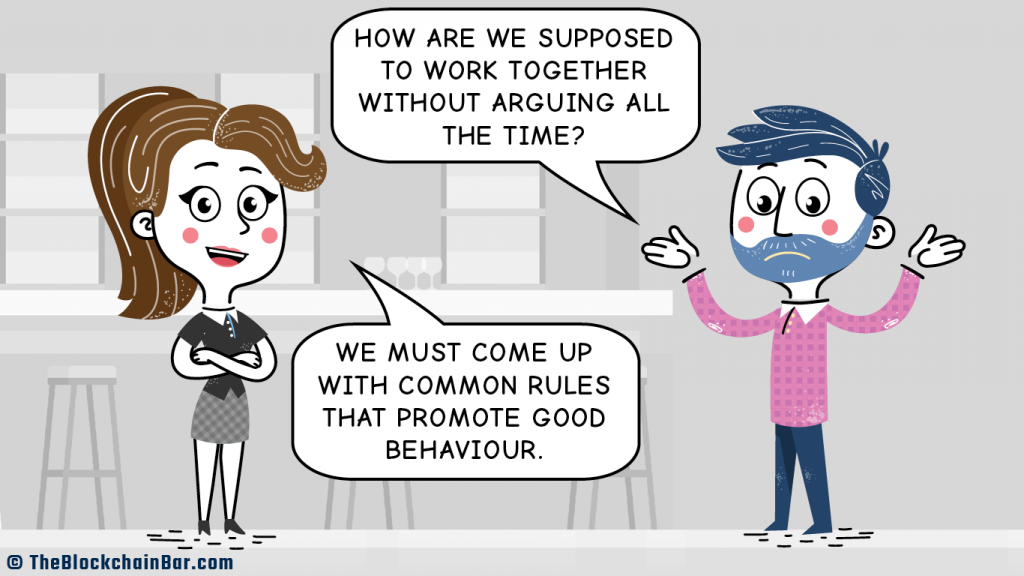Can you imagine a company without a boss? An online payment without a payment provider? A bar without a bar owner? How could this possibly work? Let’s find out!
As you know: Our friends decided to run the bar together. But of course, everybody has different ideas on how to manage the business. Oscar wants to drink for free (of course), and Alice wants to introduce her favourite craft beer.
So they agree to write down some common rules. After a lot of debate and voting rounds they have created a protocol which exactly describes how to order a drink, how to write down who drank what, how to pay, when to open and close the bar and a lot more details. Everybody signs the protocol (even Oscar) and promises to stick to it.
The core element of all blockchains is their protocol. All computers on a peer-to-peer network run the same protocol, which manages their behaviour and communication. For example, the Bitcoin protocol specifies exactly how transactions are structured and stored on the Bitcoin blockchain.
What are the elements for the Blockchain Bar’s protocol. Find out in the following episodes …
But maybe you first want to read more about blockchain protocols below.
Understanding Blockchain
Protocols let peers work towards a common goal
Oftentimes, people or organisations want to achieve the same goal, but have slightly different views on how to do that. In many cases, a lot of time is wasted on arguing about the right way to work. Or there are different views on what the goal exactly is. Or, very bad, some participants in the collective only pretend to be working towards a common goal while they really only care for their own best interest.
Therefore, in almost all areas of human activity, we have come up with sets of rules that define how to behave in certain situations. These rules give answers to questions such as
- What is expected from each member of the group or cooperative?
- How do you benefit when you stick to the rules and support the collective?
- How to reward wanted behaviour?
- How to punish wrongdoing and selfish actors?
In our daily life there are many situations in which there is no organizing central body. We still get along because we unconsciously follow protocols.
Children learn the rules of most protocols in the real world by copying the behaviour of adults. For example, when eating at a table in Europe, we hold the knife in our right hand and the fork in our left hand. If you eat your meal in any other way, you usually get strange looks from the other people at the table.
There is also a protocol for discussions: Wait until someone else has finished his or her statement. Then try starting your own sentence. If you follow that protocol, people will reward you with listening to your arguments and inviting you to the next round again.
In blockchain systems and other peer-to-peer networks, protocols define how participants should behave to make the entire system work. For example, the protocols of the Bitcoin network and other blockchains define solutions for the following problems:
- Who can join the network?
- How can one join the network?
- How do participants communicate?
- What does a transaction look like?
- How to reward the people who help running the network?
- and many more.
The common goals and objectives, the set of rules in its protocol, and its institutions and decision making processes together form the ‘governance’ model of a blockchain system.
Once a blockchain system is running and has grown to a certain size, it is very difficult and resource-intensive to change its governance. Therefore, it is crucial to get a crypto protocol right the first time.
The global crypto scene is working on best-practice methods for designing blockchain protocols and similar distributed ledger protocols. Trent McConaghy is leading these efforts and organising the community with his excellent blog posts, conference talks, and meetups on the topic.
Our bar collective will have to come up with answers to very similar questions as blockchain networks. If they want to be successful as a cooperative without a central authority, they must invent a protocol for the Blockchain Bar. They have to design and implement The Blockruption’s Blockchain Bar Protocol (Computer nerds would probably use the acronym BBBP).
The next episodes in this series will tell you about these bar rules, which happen to be strikingly similar to some concepts in blockchain technology.



